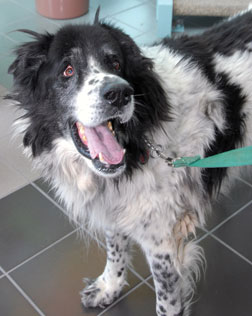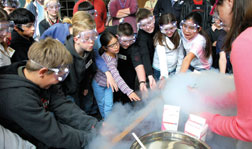NEWS RELEASES
FOR IMMEDIATE RELEASE
Feb. 20, 2007
Stolen dog workshop interests students in science
‘CSI’ — or its techniques — come to Sandia
 Beaux the Magic Chemistry Dog ready for action after
being released by his dognapper.
Beaux the Magic Chemistry Dog ready for action after
being released by his dognapper.Download 300dpi JPEG image, “beaux.jpg,” 852KB (Media are welcome to download/publish this image with related news stories.)
ALBUQUERQUE, N.M. — Adults wonder how to get kids interested in science. One way, Tim Boyle, Sandia National Laboratories materials scientist, has found is to collect them in a room and accuse them of stealing his dog. In the silence — having garnered their immediate, undivided attention — he teaches the students to use science to find who really did the deed.
Granted the approach is not systematic teaching but merely the arousal of interest in scientific techniques, still the attention he arouses in students is somewhat stunning. Elementary school students enter an impromptu laboratory classroom, sit down on a wall-to-wall rug prepared to view a chemistry magic show, and learn that Boyle’s dog Beaux — yes, Beaux the Magic Chemistry Dog — has been dognapped. Boyle thinks one of kids sitting in front of him took his pet. He tells them that he isn’t going to do the purported chemistry magic show until his dog is found.
The adrenalin-raising accusation is, of course, all in fun. The kids laugh and protest. They have their teacher and a few parents in the room for back-up. They’re not scared.
Boyle says he has a fingerprint he believes was left by the perpetrator. He challenges the kids to take a fingerprint test. Interested, they agree.
Sandia is a National Nuclear Security Administration (NNSA) laboratory.
 Liquid nitrogen freezes milk products into ice cream.
The students here, from Albuquerque’s Bellehaven Elementary School,
are participating in a “CSI”-type science lesson.
Liquid nitrogen freezes milk products into ice cream.
The students here, from Albuquerque’s Bellehaven Elementary School,
are participating in a “CSI”-type science lesson.Download 300dpi JPEG image, “ice-cream.jpg,” 712KB (Media are welcome to download/publish this image with related news stories.)
Led by Tim’s post-doctoral researcher Bernadette Hernandez-Sanchez, the volunteer staff provide each kid a pencil to blacken a square on a piece of paper. The kids press a finger on the blackness, place clear tape over the fingertip, and press that tape onto another piece of paper. Presto, each child has created a visible fingerprint.
The kids try to match their whorls, dips, and other patterns with those of the perpetrator’s, projected on a wall screen. None match? Then who stole the dog?
And now the kids are off, involved in a game in which there is no competition to be best of show, as in science fairs, or the best at solving problems in a particular field. What they are going to experience — fully — and only is using science to find the answer to a problem that interests them.
Why? “Fourth grade, fifth grade is where kids make their career choices,” Boyle says. “They say, ‘Oh, I can’t do math or chemistry,’ and they’re gone forever. Here, at a crucial moment in their lives, they get a chance to see that science is useful and fun. And that they’re good at it.”
Boyle and his staff create an artificial interest, as in the CBS TV program, “CSI: Crime Scene Investigation,” which uses intensive scientific investigation to solve crimes.
He shows pictures of four adults on a wall screen. These are the only people who were in the building at the time of the ‘nap. One is the elementary school principal. “That’s her!” the kids say excitedly. “She’s guilty!” It did not help the principal’s credibility to be the only suspect portrayed with a skeleton standing behind her.
“So, you think you can tell from a picture who’s guilty?” asks Boyle.
Now he shows a description of the habits of the four suspects. Some like dogs, some don’t. Some like ice cream, some lemonade. Some wear lab coats, some do not. The kids vote for guilt by a show of hands. They are energetic but, as a group, indecisive.
Boyle, sitting in the back of the room, raises his hand for each suspect, and his assistant Hernandez-Sanchez calls him on it.
“To me, everyone’s guilty,” he says, “until we prove otherwise.” Dressed in jeans and running shoes, a spy-vs.-spy t-shirt visible under his black corduroy jacket, with dark shades and thick dark hair combed forward over his forehead, he could be a walk-on scientist on the mathematically oriented NUMB3RS TV crime show.
“So, from habits and appearances, you can’t tell?” says Boyle. “Okay, let’s do some science.”
The kids, aided by Hernandez-Sanchez and other volunteers, inspect the “crime scene” — a collection of objects that seem to have nothing visually to do with each other, side by side: purple-colored water, the ransom note — “I have your dog! If you want to see him again, then you have to take Beaux out of the chemistry magic show”; a white spilled liquid; and other oddities. “What do you see that’s strange, that’s a little unusual?” Boyle asks.
“Purple water, right? What is that and why is it there? Is there anything that could lead us to the dognapper?” He points out other tiny bits of material that look as though they weren’t part of the original décor of the office.
Now the kids are broken up into groups. Each goes to a table where they watch or perform a particular kind of analysis. A pH test determines that one liquid found in a cup was acid-based, suggesting a drink enjoyed by two of the suspects. A chromatological ink analysis finds the ransom note was written by a gel pen. “Who uses a gel pen?” A nanotechnology lab (which takes some explaining) finds that nanoparticles of gold, treated with certain solvents, becomes purple in the water. “Who among the suspects do we know who was working with gold nanoparticles?”
At the end of the analysis, the kids file back into the conference room, sit back on the floor, and line up suspects and attributes with analysis of the clues.
“We match the evidence to the suspects,” says Boyle.
The guilty party, as portrayed unassailably, or at least most probably, by science was big, ostensibly friendly and even fatherly-appearing Sandia manager Bill Hammetter.
“Give it up, Bill,” says one kid’s voice.
“Why’d you do it, Bill?” the others shout.
“I wanted Beaux to be my dog and I wanted my cat to be used in the show,” Hammetter confesses as he returns Beaux to the room.
The kids go off to celebrate the successful solution of the case by creating liquid-nitrogen-cooled ice cream.
The show has its hidden costs. Someone needs to pay for a school bus and substitute teachers to stay with the kids who, for one reason or another, can’t come. There are supplies. Boyle figures they can handle the fourth- and fifth-graders of two schools in a week during winter break, and the same in spring. The group can excite kids in four schools a year.
Boyle tells them they can use science in jobs like engineering and chemistry and even firefighting. The group keeps statistics on many positive results arising from the three-hour event: more students turned on to science; teachers, administrators, parents all happy with the project and more aware of Sandia; the possibility of a larger student base for Sandia among local students over the years.
Sandia is a multiprogram laboratory operated by Sandia Corporation, a Lockheed Martin company, for the U.S. Department of Energy’s National Nuclear Security Administration. Sandia has major R&D responsibilities in national security, energy and environmental technologies, and economic competitiveness.
Sandia news media contact: Neal Singer, nsinger@sandia.gov, (505) 845-7078